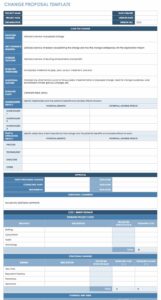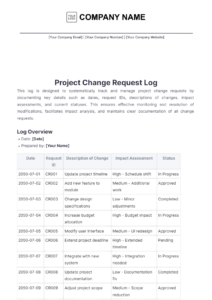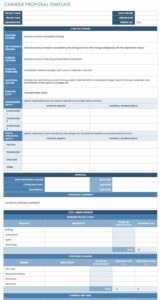Utilizing a standardized format for proposing project adjustments offers several key advantages. It ensures consistent and thorough documentation of all change requests, improving communication and transparency among stakeholders. This structured approach simplifies impact analysis, enabling project managers to effectively assess the ramifications of proposed changes on various project constraints. Furthermore, a formal process for managing change requests contributes to better control over project scope and reduces the likelihood of unauthorized or poorly planned deviations.
This article will delve deeper into the specific components of this type of structured document, practical guidance on completing it, and its integration within the broader PRINCE2 change management process.
Key Components of a PRINCE2 Change Request
A well-defined change request contains essential elements that facilitate clear communication and effective evaluation. These components ensure that proposed modifications are thoroughly documented and assessed.
1. Unique Identifier: A unique number assigned to each request allows for easy tracking and referencing throughout the project lifecycle.
2. Requestor Information: Details of the individual or group submitting the request, including their name, role, and contact information.
3. Date of Request: The date the change request was submitted.
4. Description of Change: A clear and concise explanation of the proposed modification, including the specific elements of the project affected.
5. Reason for Change: The justification for the proposed change, explaining the necessity and benefits.
6. Impact Assessment: An analysis of the potential effects of the change on project scope, schedule, cost, quality, risks, and benefits.
7. Proposed Solution: A detailed description of how the change will be implemented, including required resources and timelines.
8. Authorization Section: Space for relevant stakeholders to approve or reject the proposed change.
These components provide a structured framework for documenting and evaluating project changes, ensuring informed decision-making and effective change management.
How to Create a PRINCE2 Change Request
Creating a robust change request document is crucial for effective project management within the PRINCE2 methodology. A well-structured template ensures consistency and facilitates thorough evaluation of proposed modifications.
1. Establish a Template: Develop a standardized template incorporating the key components previously outlined. This template should be readily accessible to all project team members.
2. Assign a Unique Identifier: Allocate a unique reference number to each new request. This simplifies tracking and record-keeping.
3. Capture Requestor Details: Document the name, role, and contact information of the individual or group initiating the change request.
4. Record the Date: Clearly indicate the submission date of the request.
5. Describe the Change: Provide a concise and unambiguous description of the proposed modification, specifying the affected project areas.
6. Justify the Change: Explain the rationale behind the proposed change, highlighting the necessity and expected benefits.
7. Assess the Impact: Conduct a thorough analysis of the potential consequences of the change on project scope, schedule, cost, quality, risks, and benefits. Quantify these impacts where possible.
8. Outline the Solution: Detail the proposed implementation plan, including required resources, timelines, and assigned responsibilities.
9. Include an Authorization Section: Incorporate a designated area for relevant stakeholders to formally approve or reject the change request.
Adherence to these steps ensures comprehensive documentation, allowing for informed decision-making regarding proposed project modifications and contributes to successful project outcomes.
Effective management of change is crucial for project success. A standardized, structured approach, facilitated by a dedicated template, ensures that all proposed modifications are thoroughly documented, assessed, and authorized. This process promotes transparency, facilitates informed decision-making, and minimizes the disruptive impact of change on project objectives. Understanding the key components, creation process, and integration within the broader PRINCE2 methodology contributes significantly to controlled and efficient project delivery.
Organizations adopting PRINCE2 should prioritize the implementation and consistent use of such a template. This proactive approach to change management allows projects to adapt to evolving requirements while maintaining focus on delivering agreed-upon objectives. By embedding robust change control mechanisms, organizations enhance their ability to navigate complex project landscapes and achieve desired outcomes.



